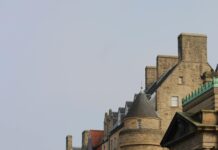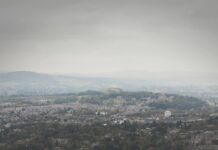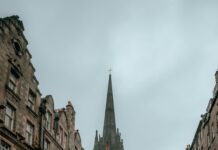Have you ever wander through the charming streets of native Edinburgh and felt the city’s rich history whispering in your ear? This captivating Scottish capital is more than just a tourist destination – it’s a living tapestry of culture, tradition, and modern vibrancy. Known for its stunning medieval architecture, Edinburgh enchants visitors with its cobblestone alleys and ancient castles. But what makes a native Edinburgh experience truly unique? It’s the little hidden gems and local secrets only those born and raised here can reveal. From the bustling Royal Mile to the serene Holyrood Park, Edinburgh offers an unforgettable blend of old-world charm and contemporary flair. Have you discovered the best-kept secrets of Edinburgh’s vibrant nightlife or the must-try traditional Scottish delicacies? Whether you’re searching for authentic Edinburgh travel tips, or aiming to explore the city like a true local, this guide unlocks everything you need to know. Curious about the top native Edinburgh experiences that go beyond the usual tourist spots? Keep reading to uncover the ultimate insider’s guide to Edinburgh – a city where history meets innovation in the most spectacular ways!
Unveiling Native Edinburgh: 7 Hidden Gems Only Locals Know
If you ever find yourself wandering through the cobbled streets of Scotland’s capital, you’d probably notice there’s a special charm that only a native Edinburgh can truly appreciate. Not really sure why this matters, but there’s something about the way locals blend history with everyday life that makes this city stand out. I mean, yeah, you got your big tourist spots like the castle and the Royal Mile, but there’s so much more behind the scenes that most visitors miss.
Now, before we go any further, let’s get one thing clear: being a native Edinburgh isn’t just about living here. It’s about knowing the quirks of the city, the slang that doesn’t make much sense to outsiders, and the hidden gems that don’t get featured on postcards. I reckon if you don’t have a decent knowledge of these things, you’re just a tourist in disguise.
The Streets and Their Stories
You can’t talk about native Edinburgh without mentioning the Old Town’s labyrinthine streets. It’s like a maze that’s been around for centuries, and honestly, I don’t think anyone really knows all the corners. Here’s a quick table to show some of the famous streets and what makes them special — or at least what the locals say about them:
| Street Name | Why It’s Loved by Locals | Odd Fact |
|---|---|---|
| Victoria Street | Brightly coloured shops, perfect for pics | Inspired Diagon Alley in Harry Potter (maybe it’s not true, but who cares) |
| Grassmarket | The go-to place for a pint and gossip | Was a marketplace for cattle in the old days |
| Cockburn Street | Steep slopes and quirky shops | Named after a judge whose name locals can’t pronounce properly |
It’s not just about the sights but the stories too. For example, the Grassmarket used to be a spot for public executions. Creepy, right? But now it’s full of pubs and lively chatter. The city’s full of these contrasts, which maybe is why being a native Edinburgh feels like you belong to something ancient and new all at once.
Local Lingo: Speak Like a Native
One of the biggest giveaways of a native Edinburgh is the way they talk. Don’t expect to understand everything straight away because the accent and slang can be a bit tricky. Here’s a quick list of phrases and words you might hear, but don’t try using them unless you’re ready to sound a bit daft:
- “Braw” – means good or excellent. “That’s a braw day for a walk.”
- “Dreich” – describes miserable weather, usually rain and grey skies.
- “Messages” – sounds confusing, but this means groceries or shopping.
- “Gie it laldy” – basically, give it your all or go hard at something.
Maybe it’s just me, but I feel like knowing these little things makes you feel like you’re part of the city’s heartbeat. It’s like a secret handshake, but with words.
Practical Tips from a Native Edinburgh Perspective
If you’re planning to stick around in Edinburgh longer than a quick visit, here’s some insider advice that only a native Edinburgh would really know:
| Tip | Explanation | Why It Matters |
|---|---|---|
| Avoid the Royal Mile at peak times | It’s packed with tourists and overpriced cafes | Go early morning or late evening for a better experience |
| Try a local bakery’s Scotch pie | A savoury meat pie that’s a proper Edinburgh treat | Cheap, filling, and perfect after a long walk |
| Use Lothian Buses for short trips | They’re frequent and cover most of the city | Saves your legs and you get to see more of the city |
And here’s a small secret: the best views of the city aren’t from the castle or Arthur’s Seat (though those are great too). Head over to Calton Hill, especially at sunset, for a panorama that not many tourists bother to find.
What Makes a Native Edinburgh?
You might be wondering, what truly separates a native Edinburgh from someone who just lives here? Well, it’s a bit like being in a club where the membership criteria is knowing which pub has the best pie, how to avoid the drunks on a Saturday night, and recognising that the weather changes by the minute. It’s about feeling a connection to the city’s rich history but also the everyday mundanities.
I once heard someone say that if you don’t complain about the weather, you’re probably not a true local. And honestly, there’s some truth to that. The weather here is notoriously fickle – one minute the sun’s shining, the next you’re soaked through. But that’s part of the charm
How to Experience Authentic Native Edinburgh: Insider Tips and Untold Secrets
If you ever find yourself wandering the cobbled streets of Edinburgh, you might start to wonder what makes a native Edinburgh so unique in their ways. Now, I’m not really sure why this matters, but there’s something about the people born and bred in this Scottish city that just can’t be copied by tourists or newcomers. Maybe it’s the way they speaks with a thick accent that sometimes feels like a secret code; or perhaps it’s just the pride they shows in their city’s rich history and culture.
Let’s dive right into some of the quirks and traits that define a native Edinburgh. First off, you’ll notice they often have a dry sense of humour, which can be confusing if you’re not used to it. You might be expecting laughter after a joke, but instead, you’ll get a raised eyebrow or a sarcastic reply. It’s like their wit is a second language that only locals really understand.
Here’s a small table to illustrate some common phrases you might hear from a native Edinburgh that’ll leave you scratching your head:
| Phrase | Meaning | When You Might Hear It |
|---|---|---|
| “Gie it laldy” | Give it your all/put effort in | At the football match or a work meeting |
| “Pure dead brilliant” | Really good or excellent | After tasting some local haggis |
| “Yer bum’s oot the windae” | You’re talking nonsense | When someone tells a ridiculous story |
Not that everybody in Edinburgh uses these phrases, but it’s common enough that you’d be surprised if you don’t hear at least one of them during a visit. Also, don’t be fooled by the friendly tone; a native Edinburgh can be quite direct and blunt when it comes to conversations. They don’t really beats around the bush, which might feel refreshing or a bit rude, depending on your background.
Moving on, the weather in Edinburgh is something that every native Edinburgh knows how to complain about endlessly. It rains, and rains, and rains some more. Not really sure why this matters, but the locals have a special talent for making any weather seem worse than it actually is. If you ever sees a group of Edinburgers chatting, there’s a great chance they are moaning about the unpredictable weather.
You might think walking around the Royal Mile or climbing Arthur’s Seat is just another tourist thing, but for a native Edinburgh, it’s almost a rite of passage. These places are part of their everyday life, not just scenic spots. Maybe it’s just me, but I feel like this connection to the city’s landmarks creates a sense of belonging that outsiders can’t easily understand.
Now, let’s talk about food for a bit. The traditional Scottish dishes are something a native Edinburgh holds dear, although not everyone will admit it openly. Haggis, neeps, and tatties are staples, but don’t expect every local to be mad about them. Some prefers a good pie or a deep-fried Mars bar (yes, it’s a thing!). Here’s a quick list of popular foods you’d find on a native Edinburgh dinner table:
- Haggis with neeps and tatties
- Cullen skink (a fish soup)
- Scotch pie
- Deep-fried Mars bars (for the brave)
- Tablet (a kind of sweet fudge)
One thing that’s often overlooked is the strong sense of community among the native Edinburgh. Despite the city growing rapidly with tourists and new residents, locals tend to stick together and support each other. It’s not like a big hug and sing-kumbaya kind of community though; it’s more like knowing who’s up for a pint and who can be trusted with your secrets.
The cultural heritage is another big part of being a native Edinburgh. The city is famous for its festivals, especially the Edinburgh Festival Fringe, which is the largest arts festival in the world. But guess what? Not every local is a fan. Some find it overwhelming or even a nuisance because it turns the city upside down every August. Still, it’s a part of their identity whether they likes it or not.
Here’s a little sheet that summarises some interesting facts about Edinburgh natives to keep things clear:
| Aspect | Description | Fun Fact |
|---|---|---|
| Language | Scots and Edinburgh dialect | Some words are completely different than standard English |
| Humour | Dry, sarcastic, sometimes blunt | Can leave outsiders confused or amused |
| Food | Traditional Scottish cuisine | Deep-fried Mars bars are a guilty pleasure |
| Community | Tight-knit but not overly friendly | Knowing someone’s local means a lot |
| Festivals | Edinburgh Festival Fringe | Largest arts festival, |
Top 5 Secret Spots in Native Edinburgh That Tourists Rarely Discover
Edinburgh, the native city of Scotland, is one of those places that just sticks with you. Maybe it’s the cobblestone streets or the ancient castles that loom over the skyline, but native Edinburgh has a vibe that few other cities can match. I mean, not really sure why this matters, but if you ever been here, you’d know what I’m on about. The mix of old and new is just bonkers in the best way possible.
The city’s history is deep, like really deep, and it’s everywhere you look. From the Royal Mile to Arthur’s Seat, native Edinburgh has layers of stories that would take you ages to unravel. You can’t just stroll through without feeling like you stepped back in time, but at the same time, it’s buzzing with modern life. Maybe it’s just me, but I feel like that’s what makes it so special.
Let’s break down some of the essentials about living or just being a native in Edinburgh:
| Aspect | Description | Why It Matters (or Not) |
|---|---|---|
| History | Castles, old buildings, tales of royalty | Feels like walking in a history book, literally |
| Weather | Rainy, windy, but sometimes surprisingly sunny | Pack an umbrella, or you’ll get caught out! |
| Culture | Festivals galore, artsy vibe, crazy nightlife | Hogmanay is a blast, if you can keep up |
| Food | Haggis, neeps, tatties, plus modern food scene | Not everyone loves haggis, but it’s a must try |
One thing that always bugs me a bit is the weather in native Edinburgh. It changes quicker than you can say “Whisky!” One minute it’s sunny, the next, you’re soaked through. I swear the rain here has a mind of its own. But then again, maybe that’s just part of the charm? The locals don’t seem bothered by it much.
Speaking of locals, native Edinburgh folk have a distinct way of speaking that can be tricky if you ain’t used to it. The accent and dialect are something else altogether, and you’ll probably find yourself asking “What did they just say?” more times than you’d like. Don’t be shy to ask again — they usually have a laugh about it. Here’s a quick glossary I made for anyone who’s not from round here:
| Word/Phrase | Meaning | Example Sentence |
|---|---|---|
| Blether | To chat or talk a lot | “We had a right good blether down the pub.” |
| Messages | Groceries or shopping | “I’m just away tae get the messages.” |
| Braw | Good, fine, or excellent | “That’s a braw day we’re having.” |
| Glaikit | Silly or foolish | “Don’t be so glaikit, you’ll be fine.” |
Now, the native Edinburgh food scene is something I can go on and on about. Sure, it’s known for haggis and all that, but it’s not just about traditional dishes anymore. There’s a whole bunch of places serving up international grub, vegan options, and fancy desserts that’ll make your mouth water. I had this one vegan cake the other day that was so good, I honestly thought it was cheating.
If you’re considering visiting or moving here, you might want to know about some practical tips that natives swear by:
- Always carry a waterproof jacket, even in summer. Trust me on this one.
- Get yourself a good pair of walking shoes. The streets are uneven and cobbly.
- Learn a few local phrases. It helps when ordering in pubs or chatting with locals.
- Be prepared for festivals — they’re amazing but can get crowded.
- Try to explore beyond the usual tourist spots. The hidden gems are where it’s at.
Here’s a quick chart for festival dates (though they can change, so check before you plan):
| Festival Name | Usual Month(s) | What To Expect |
|---|---|---|
| Edinburgh Fringe | August | Comedy, theatre, arts — madness everywhere! |
| Hogmanay | December – January | Epic New Year’s celebrations with fireworks |
| Royal Edinburgh Military Tattoo | August | Military bands, performances, and lots of pomp |
One thing I wonder about though, is why more people don’t talk about the quieter sides of native Edinburgh. Everyone’s eyes are on the festivals and castles, but there’s a peace in the parks and the residential areas that’s just lovely. It’s like the city has two faces — one loud and proud, the other calm and reflective
Why Native Edinburgh’s Local Markets Are a Must-Visit for Culture Enthusiasts
Edinburgh, the capital of Scotland, is one of those cities that’s just bursting with history and culture, but native Edinburgh locals often say it’s not just about the old buildings and the festivals. You see, the native Edinburgh experience is something that can’t really be captured by a tourist brochure or even the most enthusiastic guide. It’s a vibe, a way of living, and sometimes, a bit of a mystery to outsiders.
If you ever wander around the cobbled streets of the Old Town, you might feel like you’re stepping back in time, but don’t be fooled, the city is buzzing with modern life too. The native Edinburgh culture is a mix of tradition and contemporary living, which sometimes clash, but mostly work together in a strange harmony. Maybe it’s just me, but I feel like the people here embrace their quirks and imperfections, which makes the place feel more real.
Now, I’m not really sure why this matters, but did you know that many native Edinburgh residents still speak with a distinct Scots accent? It’s not just about the way words are pronounced, but the rhythm and flow of the language itself. This sometimes make it hard for visitors to understand everything, but locals wouldn’t have it any other way. It’s part of their identity, after all.
Here’s a quick sheet to give you an idea of some common phrases you might hear from a native Edinburgh speaker:
| Scots Phrase | English Translation | Usage Example |
|---|---|---|
| “Aye, right” | Yes, of course | “You’ll finish that by five? Aye, right.” |
| “Gie it laldy” | Give it your all | “Come on, gie it laldy at the ceilidh!” |
| “Dreich day” | Miserable weather | “It’s a dreich day, perfect for a cuppa.” |
| “Messages” | Groceries | “I need to get the messages after work.” |
The city’s landscape is another thing that the native Edinburgh population takes pride in. The famous Edinburgh Castle dominates the skyline, but it’s the smaller details, like the hidden closes (alleyways) and the bustling Grassmarket, that truly show the city’s character. Locals often like to say, “You haven’t really seen Edinburgh until you’ve got lost in the closes,” which sounds a bit bonkers, but there’s some truth to it.
If we’re talking about food, the native Edinburgh cuisine isn’t just haggis and whisky (although those are staples, no doubt). The city’s food scene has evolved massively over the past decade, with hip cafés and world cuisine popping up everywhere. However, many locals still swear by a proper Edinburgh breakfast — black pudding, tattie scones, and a strong cup of tea. Not really sure why this matters, but it’s a comforting tradition for many.
Let me throw in a little practical listing here of what a typical native Edinburgh breakfast might consist of:
- Black pudding (blood sausage, for the uninitiated)
- Tattie scones (potato cakes)
- Lorne sausage (square sausage, because why not?)
- Fried eggs (preferably runny, if you ask me)
- Baked beans (controversial addition, but quite popular)
- Strong tea or coffee (to wake you up from the dreich morning)
As you can see, it’s hearty stuff, probably the kind of meal you’d need after a night out at the famously lively pubs around Cowgate or Leith. Speaking of which, the native Edinburgh nightlife is another beast altogether. It’s not just about getting drunk; it’s about the social scene, meeting people, and enjoying traditional music sessions. The pubs have character, and you might find yourself in a snug corner with a local who won’t stop talking about the weather or football (and trust me, that’s a whole conversation in itself).
One of the things I find fascinating about the city is how the native Edinburgh community balances the influx of tourists with the preservation of their own culture. The Fringe Festival, for example, is a massive draw, but it can change the city beyond recognition for a few weeks each year. Locals often complain about the crowds and rising prices, but deep down, many love the buzz it brings. It’s a love-hate thing, really.
Here’s a little breakdown on how the city changes during the festival season, from a local’s perspective:
| Aspect | Before Festival | During Festival | After Festival |
|---|---|---|---|
| Crowd Levels | Quiet, manageable | Packed, overwhelming | Gradually calm down |
| Prices (Food & Drink) | Reasonable |
Exploring Native Edinburgh’s Best-Kept Secrets: A Guide to Off-the-Beaten-Path Attractions
Exploring the Charm of a native Edinburgh: More Than Just Castles and Bagpipes
When you think of Edinburgh, what comes to mind? Probably the majestic castle perched atop the volcanic rock, the haunting bagpipe melodies floating through the air, or the ancient cobbled streets that looks like it has been frozen in time. But if you’re a native Edinburgh or someone trying to live like one, there’s far more layers to this city than just the touristy clichés. And honestly, not everyone appreciates the little quirks that make Edinburgh unique.
Streets and Alleys: A Maze Like No Other
Every native Edinburgh will tell you that the Old Town’s labyrinth of closes and wynds is not just confusing, it’s downright bewildering. You’ll often hear someone say, “I got lost again, but at least I found a great wee pub!” Finding your way around can be a nightmare for newcomers, but for locals, it’s just part of the charm. Here’s a quick table to help you understand the typical Edinburgh street types:
| Street Type | Description | Example |
|---|---|---|
| Close | Narrow alleyways or courtyards | Mary King’s Close |
| Wynd | Small laneways between buildings | Blackfriars Wynd |
| Gait | Steps or steep streets | Victoria Street |
If you’re walking around, don’t be surprise if you accidentally stumble upon a dead end. This city wasn’t designed for GPS, that’s for sure.
Weather Talks: The Rain is Always There
Now, it’s no secret that Edinburgh’s weather can be as moody as your grumpy neighbour. It’ll be sunny one moment, then pouring the next. Maybe it’s just me, but I feel like the rain is a permanent Edinburgh resident. The locals have got this uncanny ability to say “It’s just a wee drizzle” even when the rain is more like a relentless waterfall.
An informal listing of what to expect weather-wise if you’re in Edinburgh:
- January to March: Cold and often snowy, but don’t count on snow to stay long.
- April to June: Slightly warmer, but showers are frequent.
- July to September: Warmest months, but rain is still a regular visitor.
- October to December: Chilly and wet, perfect for a cosy night in with some whisky.
Foodie Faves: Beyond Haggis and Neeps
If you think native Edinburgh only eat haggis, neeps and tatties, you’re dead wrong. Sure, that’s traditional and all, but the city’s food scene has exploded with all sorts of flavours from all over the world. The Leith area, for example, is stuffed with fantastic seafood places, while the Grassmarket is buzzing with pubs and restaurants where you can get anything from vegan dishes to gourmet burgers.
Here’s a quick sheet on some of the best spots for locals:
| Area | Specialty | Recommended Place |
|---|---|---|
| Leith | Seafood | The Ship on the Shore |
| Grassmarket | Pubs and International Cuisine | The Last Drop |
| New Town | Cafés and brunch spots | Urban Angel |
Honestly, not really sure why this matter, but the coffee culture here is surprisingly good for a city that’s known more for whisky. Maybe the rain drives people indoors to sip on lattes.
Festivals That Keep The City Buzzing
Edinburgh is famous for its festivals, but the thing is, if you’re a native Edinburgh, you sometimes just avoid the crowds like the plague. The Edinburgh Fringe Festival, for instance, is amazing, but the streets gets so packed you can barely move. Locals will often say, “I’ll watch the shows on telly, thanks.”
A quick glance at the main festivals and what they’re about:
| Festival | When | What’s It About |
|---|---|---|
| Edinburgh Fringe | August | The world’s largest arts festival |
| Hogmanay | New Year | Massive street party and fireworks |
| Royal Edinburgh Military Tattoo | August | Military bands and performers |
The Accent That Confuses Everyone
If you’re not native Edinburgh, good luck understanding the accent. It’s thick, fast, and full of slang. Even other Scots can struggle sometimes. Words like “braw” (meaning fine or good) or “pure dead brilliant” (really great) can throw you off. Locals often chuckle when tourists try to mimic the accent and fail spectacularly.
A small glossary for the curious:
| Word/Phrase | Meaning |
|---|---|
| Braw | Fine, good |
| Pure dead brilliant |
Conclusion
In conclusion, Native Edinburgh offers a captivating glimpse into the city’s rich cultural heritage, vibrant contemporary life, and stunning natural landscapes. From its historic Old Town and iconic landmarks like Edinburgh Castle to the thriving arts scene and welcoming local communities, the city embodies a unique blend of tradition and modernity. Exploring Native Edinburgh allows visitors to connect with its authentic spirit, whether through its festivals, culinary delights, or hidden gems tucked away in charming streets. Embracing the local culture not only enriches the travel experience but also fosters a deeper appreciation for Edinburgh’s enduring legacy. For anyone planning a visit, taking the time to discover the city’s native essence promises unforgettable memories and a true sense of place. So, why not embark on your own journey to Native Edinburgh and uncover the stories that make this Scottish capital so extraordinary?













